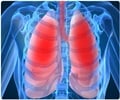Researchers at the University of Iowa found that CT scans can help identify smokers at risk of emphysema.
Researchers at the University of Iowa have found that CT scans can help identify smokers at risk of emphysema.
The team discovered that smokers who have very subtle signs of emphysema, but still have normal lung function, have very different blood flow patterns in their lungs compared to non-smokers and smokers without signs of emphysema.This difference could be used to identify smokers at increased risk of emphysema and allow for early intervention.
Lead author Eric Hoffman, UI professor of radiology, internal medicine and biomedical engineering, said: "We have developed a new tool to detect early emphysema-related changes that occur in smokers who are susceptible to the disease.
"Our discovery may also help researchers understand the underlying causes of this disease and help distinguish this type of emphysema from other forms of chronic obstructive pulmonary disease. This type of CT scan could even be a tool to test the effectiveness of new therapies by looking at the changes in lung blood flow."
The scientists used multi-detector row CT imaging to measure blood flow patterns in the lungs of 41 study participants - 17 non-smokers and 24 smokers.
All the participants had normal lung function, but 12 of the smokers had very subtle signs of emphysema.
Advertisement
The findings also support the idea that abnormal blood flow occurs before emphysema develops.
Advertisement
Hoffman said: "Our study suggests that some smokers have an abnormal response to inflammation in their lungs; instead of sending more blood to the inflamed areas to help repair the damage, blood flow is turned off and the inflamed areas deteriorate."
The cellular pathway that turns off blood flow is helpful when an area of the lung has become permanently blocked and cannot be rescued. In that case, the lung "optimizes gas exchange" and stops supplying the area with blood.
However, lung inflammation caused by smoking can be resolved and resultant damage repaired by increased blood flow, which brings oxygen and helpful cellular components to the site of injury.
This study suggests that the ability to distinguish when to turn off or when to ramp up blood flow is defective in some people - probably due to genetic differences. If this genetic difference is coupled with smoking, which increases lung inflammation, that could increase the risk of developing emphysema.
The findings of the study have been published in the Early Edition of the Proceedings of the National Academy of Sciences.
Source-ANI
THK












